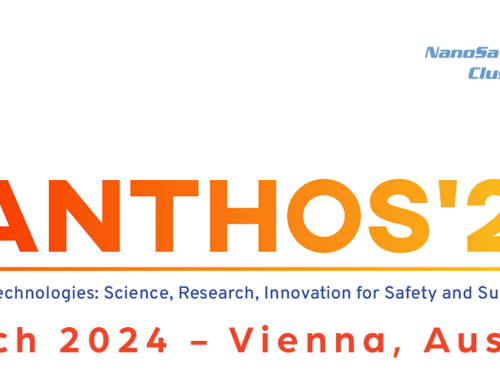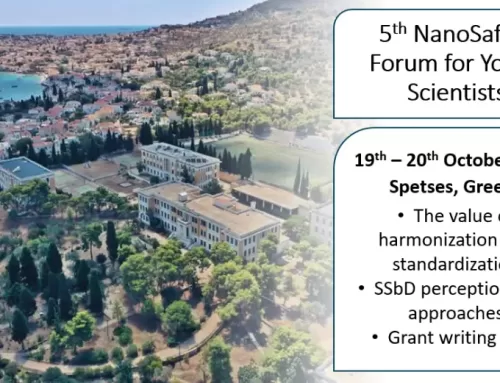30 November 2022
We are proud to inform you that our ECRs, Lara Faccani, won the prize “ESG (Environmental, Social and Governance) Challenge Iren 2023” for the best 10 thesis dealing with the topic of sustainability and ESG challenges. The thesis is entitled “NANO – PHOTOCATALYSTS: DESIGN, UP – SCALE AND CHARACTERISATION MODELS” and it was written by Lara Faccani, under the supervision of the ASINA Project Coordinator Anna Luisa Costa and Simona Ortelli and coordinated by Prof. Enrico Dalcanale, for her Ph.D thesis dissertation at the University of Parma – PhD in Material Science and Technology.
We are happy to share this result because the research of ASINA and, in particular, the fundamental contribution given by Massimo Perrucca (Case study for the multi-objective optimization of different photocatalysts) and Irini Furxhi (Machine Learning Tool applied to pro-oxidative potential of different photocatalysts), inspired this work and allowed her to improve the quality and relevance of her Ph.D Thesis results.
So, congratulations to Lara and a special thanks to Massimo and Irini, but also to ASINA projects and its beautiful partners.
Read the thesis abstract in Italian and English below:
Abstract (ITA)
La carenza di acqua potabile nei paesi sottosviluppati e la crescente quantità di inquinanti emergenti nelle zone fortemente industrializzate rappresentano due criticità estreme dell’attuale quadro globale. Gli inquinanti emergenti non vengono rimossi dalle attuali tecniche di purificazione, da cui la necessità di indagare nuove tecnologie, come le nanotecnologie, in grado di sottrarre all’acqua contaminanti potenzialmente tossici.
Questa tesi propone quattro soluzioni principali, come punti chiave di innovazione.
1. Sviluppo e caratterizzazione chimico-fisica e funzionale di nano-fotocatalizzatori in un’ottica di Safe-and-Sustainable-by-Design (SSbD).
Sono stati sviluppati e caratterizzati quattro diversi nano-fotocatalizzatori: nanosol di biossido di titanio (TAC) di origine commerciale, polvere di nitruro di carbonio sintetizzato termicamente (g-C3N4); nanosol di biossido di titanio etero-coagulato con biossido di silice (TiO2:SiO2); polvere di biossido di titanio supportata su grafene ossido, ottenuta con metodo sonochimico (TGO).
Le proprietà strutturali, colloidali e optoelettroniche, sono state misurate, e correlate a quelle funzionali, utilizzando come modello di inquinante organico il colorante Rodamina B e come fonte di irraggiamento lampada UV o simulatore solare. Alle prestazioni funzionali sono stati affiancati profili di costo e sostenibilità ambientale valutati con modelli di Life Cycle Assessment e Life Cycle Costing, applicati alla fase di utilizzo dei materiali. Dallo studio è emerso che il materiale TAC e il composito da esso formulato (TiO2:SiO2) garantiscono aree di decisione maggiori.
2. Scale-up di un foto-reattore su scala semi-pilota utilizzando nano-fotocatalizzatori supportati su tessuti.
In risposta alla necessità di trasferire conoscenze e tecnologie messe a punto su scala di laboratorio ad una scala di interessa industriale, i nano-fotocatalizzatori sono stati immobilizzati su supporti tessili ed inseriti come matrici attive in un impianto pre-pilota (6L). Da una ottimizzazione multi-variabile (tipo di irraggiamento, temperatura di lavoro, tipo di tessuto, tipo di rivestimento), sulla base della funzionalità dei nano-fotocatalizzatori, è emersa come strategia vincente l’applicazione di un rivestimento di TiO2:SiO2 su cotone, ad una temperatura di lavoro di 25°C.
3. Sviluppo di modelli sperimentali predittivi del potere ossidativo dei nano-fotocatalizzatori come indicatori della loro funzionalità e del potenziale (eco) tossico.
In risposta alla necessità sempre più sentita di avere a disposizione metodi veloci e semplici per valutare gli indicatori, associati alla reattività superficiale dei nanomateriali, predittivi di una loro reattività funzionale e biologica, è stato valutato il consumo delle due coppie redox GHS/GSSG e Cisteina/Cistina, in prima linea nella difesa cellulare da agenti ossidanti, così come la ossidazione mediata da OH• della p-nitroanilina (RNO). Si è evinto che il materiale che maggiormente richiede chimici nella sua sintesi, il TGO, ha un elevato potere ossidativo mentre l’accoppiamento della SiO2 con il TiO2 permette di aumentare l’efficienza fotocatalitica, a dispetto di una diminuita produzione di ROS, facendo così del materiale TiO2:SiO2 un ottimo candidato in un’ottica di SSbD.
4. Identificazione e caratterizzazione di una nuova classe di inquinanti: micro-nano plastiche (MNPs).
In risposta al crescente interesse per gestire una classe emergente di inquinanti, ovvero le micro-nano plastiche sono state caratterizzate alcune plastiche di maggiore rilievo (PE, PS e PET) e studiati i metodi di dispersione in matrici ambientali, sfruttando approcci e protocolli messi a punto dallo studio delle nanoparticelle. Dallo studio è emerso che attraverso la semplice misura del potenziale zeta e del punto isoelettrico è possibile individuare se sono presenti additivi di sintesi e come influenzano lo stato di dispersione.
Abstract (ENG)
Two extremes in a current world are present: the deficiency of drinking water in underdeveloped countries and the growing amount of emerging pollutants in highly industrialized areas. Emerging pollutants are not removed by current wastewater treatment common to most urban wastewater treatment plants, therefore there is a need to investigate new technologies, such as nanotechnologies, capable to remove potentially toxic contaminants from water.
This thesis proposes four main solutions, as key points of innovation.
1. Devolepment and physic-chemical and functionality characterization of nano – photocatalysts following Safe-and-Sustainable-by-Design (SSbD) approach.
Four different nano-photocatalysts have been developed and characterized: Commercial titanium dioxide nanosol (TAC); thermally synthesized carbon nitride powder (g-C3N4); hetero-coagulated titanium dioxide nanosol with silica dioxide (TiO2:SiO2); titanium dioxide powder supported on graphene oxide, obtained with sonochemical method (TGO).
The structural, colloidal and optoelectronic properties were measured, and correlated to the functional ones, using the Rhodamine B dye as an organic pollutant model and UV lamp or solar simulator as an irradiation source. The functional performance was coupled by cost and environmental sustainability profiles evaluated with Life Cycle Assessment and Life Cycle Costing models, applied to the materials use phase. The study showed that the TAC material and the composite formulated by it (TiO2:SiO2) guarantee greater decision areas.
2. Scale-up of a semi-pilot photoreactor for nano – photocatalysts integration supported by fabrics.
In response to the need to transfer knowledge and technologies developed on a laboratory scale to a scale of industrial interest, the nano-photocatalysts were immobilized on textile supports and inserted as active matrices in a pre-pilot plant (6L). From a multi-variable optimization (type of irradiation, working temperature, type of fabric, type of coating), based on the functionality of the nano-photocatalysts, the application of a TiO2:SiO2 coating on cotton at a working temperature of 25 ° C, emerged as a winning strategy.
3. Development of experimental models, predictive of the functionality of nano – photocatalysts and their eco-toxic potential.
In response to the increasingly felt need to have fast and simple methods available to evaluate the indicators, associated with the surface reactivity of nanomaterials, predictive of their functional and biological reactivity, the consumption of the two redox pairs GHS / GSSG and Cysteine / Cystine, at the forefront of cellular defence from oxidizing agents, as well as the OH • mediated oxidation of p-nitroaniline (RNO) was evaluated. It was found that the material that most requires chemicals in its synthesis, TGO, has a high oxidative power while the coupling of SiO2 with TiO2 allows to increase the photocatalytic efficiency, in spite of a decreased ROS production, thus doing of the TiO2:SiO2 material an excellent candidate in terms of SSbD.
4. Identification and characterization of new class of pollutants: micro – nano plastics (MNPs).
In response to the growing interest in managing an emerging class of pollutants, namely micro-nano plastics and evaluating the impact that may derive from exposure to both humans and the environment, some major plastics have been characterized (PE, PS and PET) and studied the methods of dispersion in environmental matrices, exploiting approaches and protocols developed from the study of nanoparticles. Thanks to the participation in the European project PlasticsFate, we had access to a repository of representative MNPs, different by type of polymer, origin, size and use scenarios. The study showed that by simply measuring the zeta potential and the isoelectric point, it is possible to identify whether synthetic additives are present and how they influence the state of dispersion.






Leave A Comment